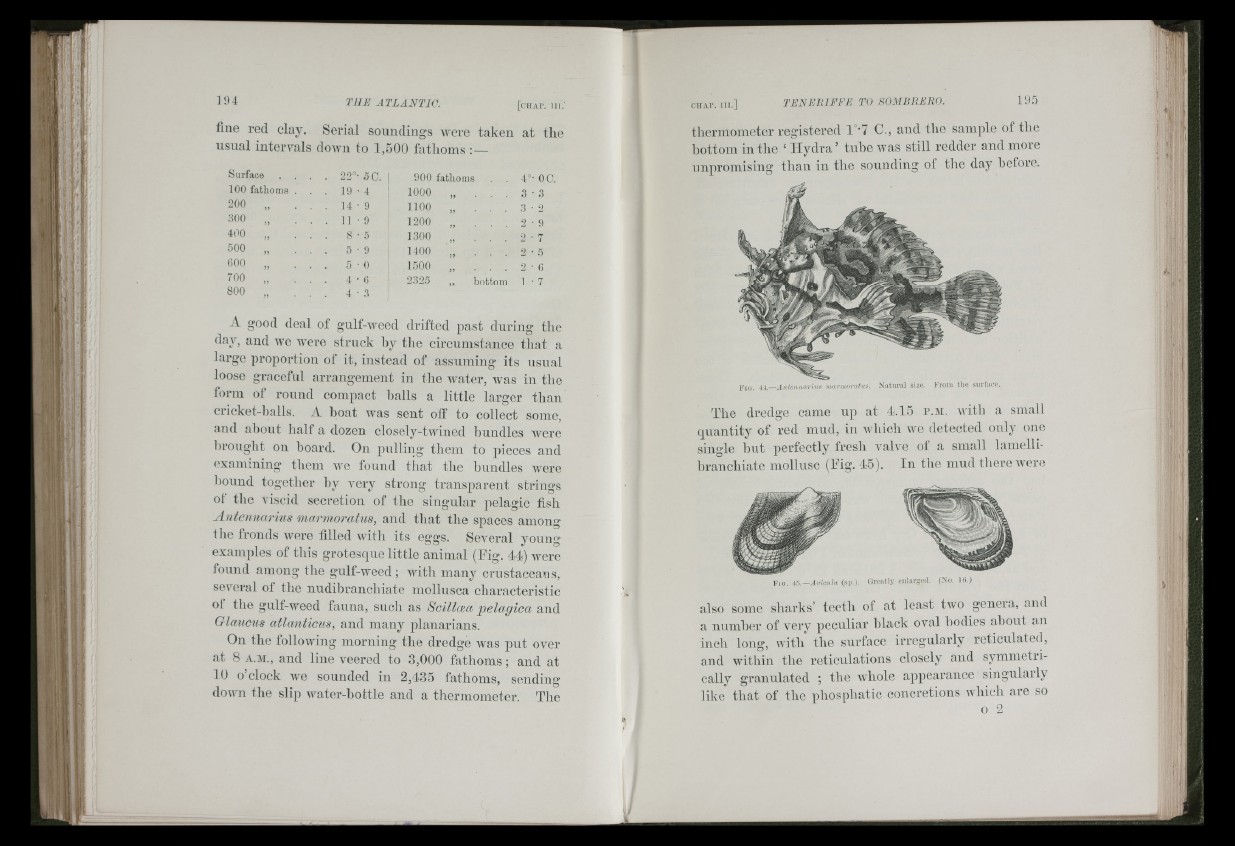
A li-f
i r i iH
a i i i I
line red elay. Serial soundings Avere taken at the
usual intervals doAvu to 1,500 fathoms
Surface
100 fathoms .
200 „ .
300 „ .
400 „ .
500 „ .
000 „ .
700 „ .
800 ..
22°-
19 •
14 •
11 ■
8 •
5 •
5 •
4 •
4 •
5C.
4
9
9
5
9
0
G
3
900 fathoms
1000 „ .
1100 „ .
1200 „ .
1300 „ .
1400 „ .
1500 „ ,
2325 ,
4°
3
3
2
2
o
OC.
32
9
7
5
. 2-6
bottom 1 • 7
A good deal of gulf-Aveed drifted past during tlie
day, and Ave Avere struck hy the circumstance that a
large proportion of it, instead of assuming its usual
loose graceful arrangement in the Avater, Avas iu the
form of round compact halls a little larger than
cricket-balls. A boat Avas sent off to collect some,
and about half a dozen closely-tAA'ined bundles Avere
brought on board. On pulling them to pieces and
examiuing them Ave found tiiat the bundles Avere
hound together hy A'ery strong transparent strings
ol the viscid secretion of the singular pelagic fish
Antennarius marmoratus, and that the spaces among
the fronds AA'cre filled AA'ith its eggs. ScA'eral young
examples of this grotesque little animal (Fig. 44) Avere
found among the gulf-Aveed ; Avith many crustaceans,
scA'eral of the nudibranchiate mollusca characteristic
of the gulf-Aveed fauna, such as Sciltoea pelagica and
Glauciis atlanticus, and many planarians.
On the folloAving morning the dredge Avas put over
at 8 a.m., and line veered to 3,000 fathoms ; and at
10 o clock Ave sounded in 2,435 fathoms, sending
doAvn the slip Avater-hottle and a thermometer. The
thermometer registered 1°'7 C., and the sample of the
hottom in the ‘ Hydra ’ tube Avas still redder and more
nupromising than iu the sounding of the day before.
Fig. 44.— A n te n n a r iu s m a rm o ra tu s . Natural size. From the surtaeo.
The dredge came up at 4.15 p.m. Avitli a small
quantity of red mud, in Avhich Ave detected only one
single but perfectly fresli valve of a small lamelli-
hrauchiate mollusc (Fig. 45). In the mud there Avere
Fig. 45.- A v i c u l a (sp.). Greatly enlarged. (No. 16.)
also some sharks’ teeth of at least tAvo genera, and
a number of very peculiar hlack oval bodies about an
inch long, with the surface irregularly reticulated,
and within the reticulations closely aud symmetrically
granulated ; the Avliole appearance singularly
like that of the phosphatic concretions AA'hich are so
o 2
■i r'- i , Hkik.
At